
|

|

|
| Animations: Runaway stars |
| Articles about my work |
| Scientific publications |
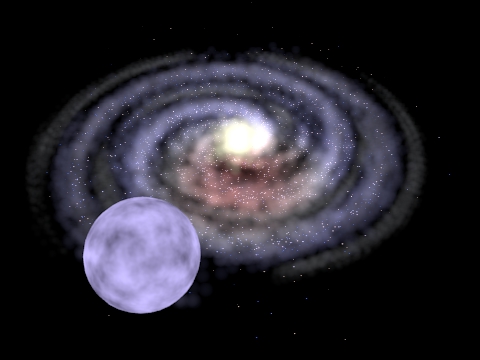 Young, massive stars in the Galactic halo are far away from Milky Way’s star forming regions, i.e., its spiral arms within the Galactic plane.
Thus, those objects are widely supposed to be the result of an ejection event from the Galactic disk forcing them to leave their place of birth as
so-called runaway stars.
Young, massive stars in the Galactic halo are far away from Milky Way’s star forming regions, i.e., its spiral arms within the Galactic plane.
Thus, those objects are widely supposed to be the result of an ejection event from the Galactic disk forcing them to leave their place of birth as
so-called runaway stars.Possible ejection scenarios are the tidal disruption of a binary system by a supermassive black hole (called slingshot mechanism or "Hills mechanism"), dynamical interactions in dense star clusters, e.g., close binary-binary encounters ejecting one or even two stars, or a supernova explosion in a binary system. |
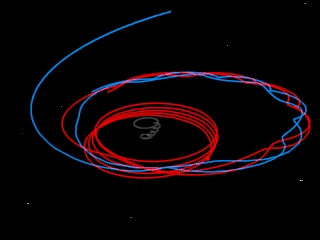 Among the different ejection scenarios, the Hills mechanism is most powerful in terms of ejection velocities (up to thousand kilometers
per second). It is supposed to be responsible for a very rare class of extreme velocity stars, the so-called hypervelocity stars, traveling at such a high velocity
that one day they will escape from the Milky Way. Because the Galactic center is the only region known to host a supermassive black hole, it is the suggested place of
origin for the hypervelocity stars.
Among the different ejection scenarios, the Hills mechanism is most powerful in terms of ejection velocities (up to thousand kilometers
per second). It is supposed to be responsible for a very rare class of extreme velocity stars, the so-called hypervelocity stars, traveling at such a high velocity
that one day they will escape from the Milky Way. Because the Galactic center is the only region known to host a supermassive black hole, it is the suggested place of
origin for the hypervelocity stars.
|
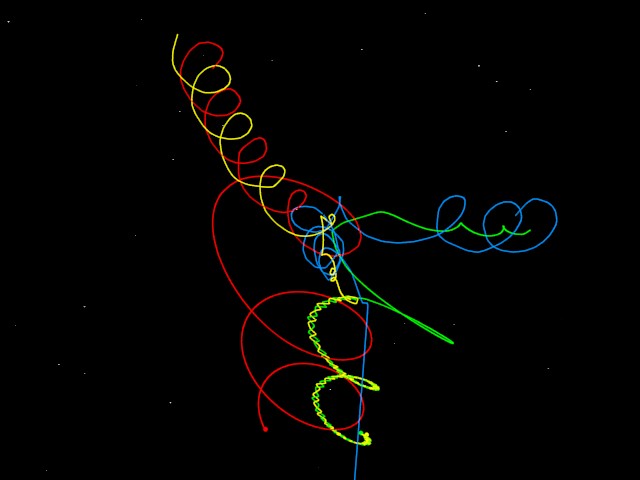
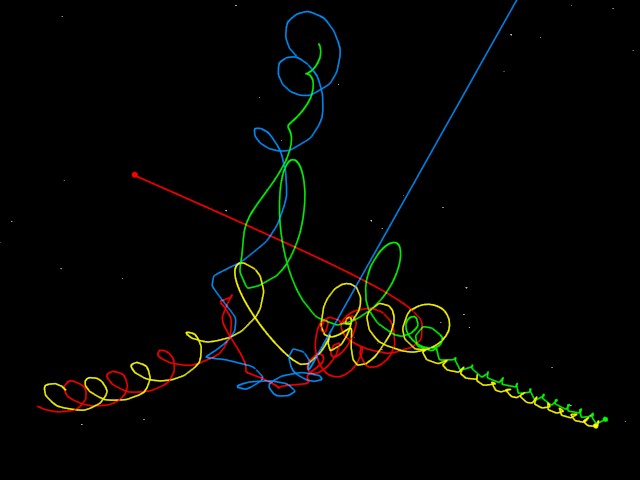
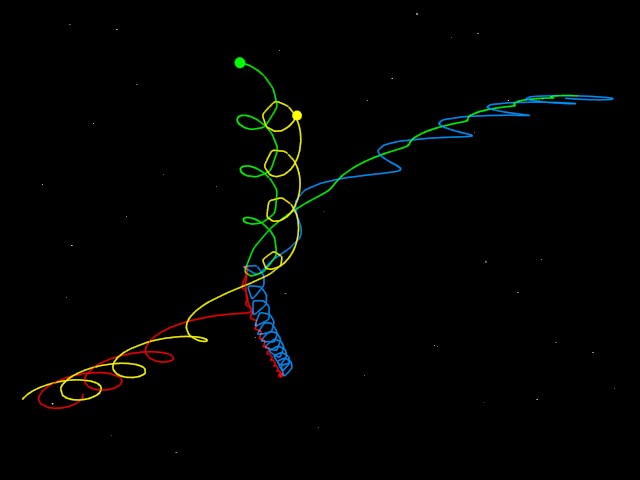 Dynamical interactions in star clusters - either initial dynamical relaxation or close many-body encounters such as binary-binary interactions in dense, compact
and massive star clusters - are capable to transfer enough kinetic energy to at least one of the involved components to let it escape from the entire cluster with
ejection velocities up to several hundred kilometers per second. The outcome of the encounter is hereby very sensitive to the initial conditions. For instance, by
slightly varying the initial parameters, binary-binary interactions can produce a single runaway star leaving behind a stable
hierarchical triplet system, two runaway stars subsequently ejected from the chaotic four or three body system, respectively,
finally leaving behind a very close binary system, or no runaway star at all but instead result in an exchange of components.
Given the spatial density of stars and from that the probability for a sufficient close encounter to happen, massive clusters are by far the most likely objects to
dynamically eject runaway stars.
Dynamical interactions in star clusters - either initial dynamical relaxation or close many-body encounters such as binary-binary interactions in dense, compact
and massive star clusters - are capable to transfer enough kinetic energy to at least one of the involved components to let it escape from the entire cluster with
ejection velocities up to several hundred kilometers per second. The outcome of the encounter is hereby very sensitive to the initial conditions. For instance, by
slightly varying the initial parameters, binary-binary interactions can produce a single runaway star leaving behind a stable
hierarchical triplet system, two runaway stars subsequently ejected from the chaotic four or three body system, respectively,
finally leaving behind a very close binary system, or no runaway star at all but instead result in an exchange of components.
Given the spatial density of stars and from that the probability for a sufficient close encounter to happen, massive clusters are by far the most likely objects to
dynamically eject runaway stars.
|

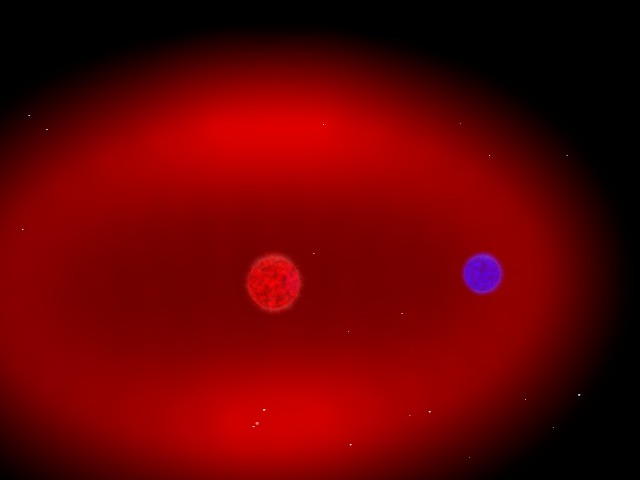 A runaway star might also be the surviving secondary component of a binary system whose primary and hence more evolved star exploded as a
supernova enabling its companion to escape from the former bound system (provided the mass loss during the explosion
was sufficient). For symmetric supernova explosions, the ejection velocity is proportional to the orbital velocity of the future runaway
star yielding relatively moderate ejection velocities (less than one hundred kilometers per second) for standard binary systems. In order to
compete with those ejection velocities occurring in dynamical interactions (several hundred kilometers per second), very close progenitor systems
are required. Such configurations can be the result of a previous common-envelope phase triggered by the primary
component’s rapid expansion when becoming a red giant prior to its supernova explosion. Viscous forces between the stars and the common-envelope
then lead to a spiraling-in of the stellar components until the common-envelope is expelled due to the deposition of orbital energy. The
subsequent supernova explosion of the resulting Wolf-Rayet star eventually disrupts the compact binary system releasing a high-speed runaway star.
A runaway star might also be the surviving secondary component of a binary system whose primary and hence more evolved star exploded as a
supernova enabling its companion to escape from the former bound system (provided the mass loss during the explosion
was sufficient). For symmetric supernova explosions, the ejection velocity is proportional to the orbital velocity of the future runaway
star yielding relatively moderate ejection velocities (less than one hundred kilometers per second) for standard binary systems. In order to
compete with those ejection velocities occurring in dynamical interactions (several hundred kilometers per second), very close progenitor systems
are required. Such configurations can be the result of a previous common-envelope phase triggered by the primary
component’s rapid expansion when becoming a red giant prior to its supernova explosion. Viscous forces between the stars and the common-envelope
then lead to a spiraling-in of the stellar components until the common-envelope is expelled due to the deposition of orbital energy. The
subsequent supernova explosion of the resulting Wolf-Rayet star eventually disrupts the compact binary system releasing a high-speed runaway star.
|
|
All the animations above were created using the free open source tool Blender. Many thanks to Luke Schiefelbein for introducing
the software to me and for providing his Python script to read trajectories from an external file! I am also very grateful to Sara Nagelberg for writing a Python script
to draw trails and for providing the Galaxy model used in the runaway animation! In order to create animated GIFs from the Blender output, I made use of
GIMP, a free image editor.
To make the animations as realistic as possible, all trajectories (except for the Milky Way runaway star) were calculated numerically starting from reasonable physical conditions. To solve the equations of motion, a fourth-order Runge-Kutta-Fehlberg algorithm was applied. In the binary-binary interactions, three stars of five solar masses and one star (the blue sphere) of one solar mass were involved. The radii of the stars were scaled under the assumption that they have solar density and then multiplied by a factor of ten for the sake of visualization. The run-times of these animations correspond to approximately five years in real time. To have time and length scales appropriate for an animation, the mass of the supermassive black hole in the slingshot scenario had to be reduced to 500 solar masses (instead of several millions) while at the same time the masses of the two stars were set to the rather high value of 25 solar masses. In this way, the gravitational force between the stars was of the same order of magnitude as the black hole’s tidal force enabling the latter to disrupt the binary system. Holding this balance of forces while increasing the black hole mass requires to move the binary system further away from it, which makes the system inappropriate for visualization. Again, stellar radii were scaled from solar density and increased by a factor of ten. The run-time of this event in real time is about 27 years. The binary system in the supernova as well as common-envelope animation consists of a 15 solar mass primary and a five solar mass secondary component. Orbital periods are 1.5 and 4.9 days, respectively. Radii were chosen such that the major object is a compact Wolf-Rayet star while the minor one is a slightly evolved main sequence star. Numerically, the supernova explosion was implemented by instantaneously reducing the primary’s mass to 1.4 solar masses (canonical mass of a neutron star) and neglecting all other effects. The viscous forces during the common-envelope phase were simulated by adding a velocity-dependent friction term to the equations of motion. This implementation, in particular the strength of the corresponding damping constant, as well as the size and duration of the envelope were not based on any physical facts but chosen solely for the sake of visualization. Although the trajectory for the star escaping from the spiral galaxy was not calculated, the animation is still quite realistic when considering a very fast runaway star. |
|
The animations below were created with the computer algebra system MAPLE. They are not as realistic
as the previous ones in terms of underlying physics as well as visualization and therefore obsolete.
|
|
|